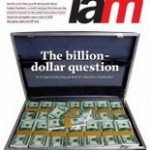 The newest Intellectual Asset Management Magazine (IAM) revisits what is probably the most important, and most troubling, issue pervading the IP market today: Intellectual property valuation. I have visited the topic in a number of posts, and this trend probably won’t stop anytime soon. The IAM article is another step in the right direction, authored by Pat Sullivan, who has taken the reigns on the conversation of standard setting in IP valuation.
The newest Intellectual Asset Management Magazine (IAM) revisits what is probably the most important, and most troubling, issue pervading the IP market today: Intellectual property valuation. I have visited the topic in a number of posts, and this trend probably won’t stop anytime soon. The IAM article is another step in the right direction, authored by Pat Sullivan, who has taken the reigns on the conversation of standard setting in IP valuation.
While I encourage everyone to find this issue of IAM, if not every issue, I understand it may be an expensive endeavor, in which case I urge you to read the IAM blog, where Joff Wild summarizes the article and the Top Ten Myths in IP valuation. As Joff identifies them, they are, in order:
- Myth #1 - value is a well-defined and well-understood term
- Myth #2 -the value of an intangible is equal to the price someone is willing to pay
- Myth #3 - value is equal to the cost of creating an item
- Myth #4 - each intangible should have only one official value
- Myth #5 - the balance sheet provides good information about the value of intangibles
- Myth #6 - fair market value is a good construct for use with intangibles valuation
- Myth #7 - there should be only one accepted method for valuing intangibles
- Myth #8 - a current estimate of future price must equal the eventual transaction price in order to be considered accurate
- Myth #9 - patents cannot be valued credibly because each one is unique
- Myth #10 - The value of a company’s intangibles is the difference between its market value and the value of its tangible assets
Joff touches on each of these briefly in his post.
I should also included Myth #11, added as a comment by the IP guru and timely comic relief, Duncan Bucknell:
- Myth#11 - we are making headway into a worldwide set of standards for valuing IP?
I’d like to touch on Myth #7. I have read the article, and I agree with almost all of the suggestions about the state of the valuation process conveyed by Pat Sullivan. However, I believe that, although we may not need or be able to utilize a single standardized method for valuing all IP under all circumstances, there needs to be a standard setting guideline to set the most appropriate method used in particularly common transactions/valuations. Thus, in all straight forward asset sales involving a patent with license and royalty historicals, an income approach is used. Or, in all M&A transactions in which the valuation of core IP without a cash-flow stream must take place, a value-added approach is used where both parties estimate that figure, and the average is taken (oversimplified for the sake of creating an example).
In any regard, it is important that the conversation has reached the public debate by way of the media, if only industry-specific media, and the issue is being approached and understood. We can now move forward with meaningful attempts at a standard setting process (not a standard method), in an effort to help shape the IP market.
 Ian McClure is a former corporate & securities and intellectual property law attorney with
Ian McClure is a former corporate & securities and intellectual property law attorney with  Trevor M. Blum is a former Associate in the Chicago-based, valuation practice group of Ocean Tomo, LLC., an intellectual property (IP) consultancy. Additionally, he provided instrumental research support to Intellectual Property Exchange International, Inc., an IP exchange start-up. Trevor holds a B.S. from Indiana University and is currently an MBA candidate at the University of Cambridge, focusing on international business and finance. His interests also include entrepreneurship, economics, and informational visualization. He enjoys running and cycling in his free time. Trevor seeks to bring a transnational business perspective to the blog.
Trevor M. Blum is a former Associate in the Chicago-based, valuation practice group of Ocean Tomo, LLC., an intellectual property (IP) consultancy. Additionally, he provided instrumental research support to Intellectual Property Exchange International, Inc., an IP exchange start-up. Trevor holds a B.S. from Indiana University and is currently an MBA candidate at the University of Cambridge, focusing on international business and finance. His interests also include entrepreneurship, economics, and informational visualization. He enjoys running and cycling in his free time. Trevor seeks to bring a transnational business perspective to the blog. 
One Comment, Comment or Ping
Reply to “The IP Valuation Conversation Continues . . .”